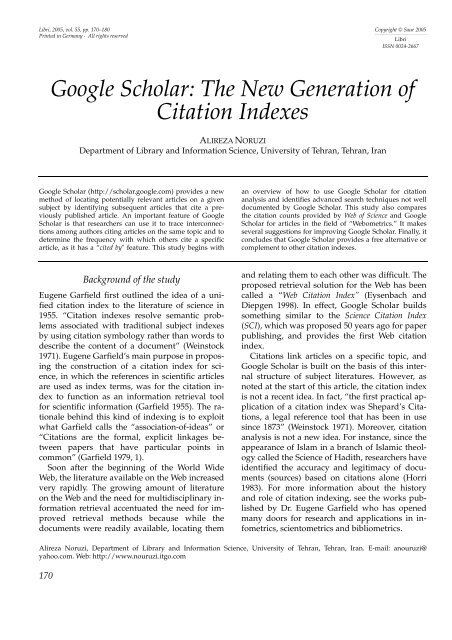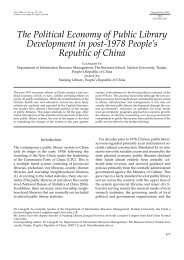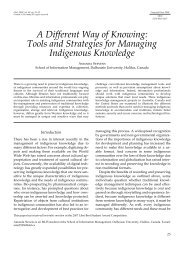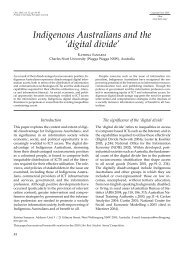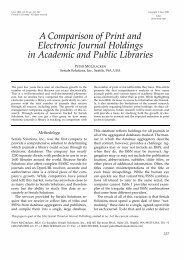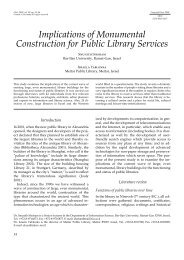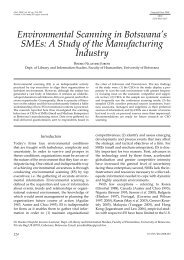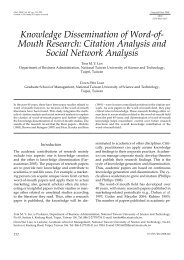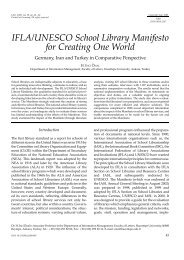Google Scholar: The New Generation of Citation Indexes - Libri
Google Scholar: The New Generation of Citation Indexes - Libri
Google Scholar: The New Generation of Citation Indexes - Libri
You also want an ePaper? Increase the reach of your titles
YUMPU automatically turns print PDFs into web optimized ePapers that Google loves.
<strong>Libri</strong>, 2005, vol. 55, pp. 170–180Printed in Germany · All rights reservedCopyright © Saur 2005______________________________________________<strong>Libri</strong>ISSN 0024-2667<strong>Google</strong> <strong>Scholar</strong>: <strong>The</strong> <strong>New</strong> <strong>Generation</strong> <strong>of</strong><strong>Citation</strong> <strong>Indexes</strong>ALIREZA NORUZIDepartment <strong>of</strong> Library and Information Science, University <strong>of</strong> Tehran, Tehran, Iran<strong>Google</strong> <strong>Scholar</strong> (http://scholar.google.com) provides a newmethod <strong>of</strong> locating potentially relevant articles on a givensubject by identifying subsequent articles that cite a previouslypublished article. An important feature <strong>of</strong> <strong>Google</strong><strong>Scholar</strong> is that researchers can use it to trace interconnectionsamong authors citing articles on the same topic and todetermine the frequency with which others cite a specificarticle, as it has a “cited by" feature. This study begins withan overview <strong>of</strong> how to use <strong>Google</strong> <strong>Scholar</strong> for citationanalysis and identifies advanced search techniques not welldocumented by <strong>Google</strong> <strong>Scholar</strong>. This study also comparesthe citation counts provided by Web <strong>of</strong> Science and <strong>Google</strong><strong>Scholar</strong> for articles in the field <strong>of</strong> “Webometrics.” It makesseveral suggestions for improving <strong>Google</strong> <strong>Scholar</strong>. Finally, itconcludes that <strong>Google</strong> <strong>Scholar</strong> provides a free alternative orcomplement to other citation indexes.Background <strong>of</strong> the studyEugene Garfield first outlined the idea <strong>of</strong> a unifiedcitation index to the literature <strong>of</strong> science in1955. “<strong>Citation</strong> indexes resolve semantic problemsassociated with traditional subject indexesby using citation symbology rather than words todescribe the content <strong>of</strong> a document” (Weinstock1971). Eugene Garfield’s main purpose in proposingthe construction <strong>of</strong> a citation index for science,in which the references in scientific articlesare used as index terms, was for the citation indexto function as an information retrieval toolfor scientific information (Garfield 1955). <strong>The</strong> rationalebehind this kind <strong>of</strong> indexing is to exploitwhat Garfield calls the “association-<strong>of</strong>-ideas” or“<strong>Citation</strong>s are the formal, explicit linkages betweenpapers that have particular points incommon” (Garfield 1979, 1).Soon after the beginning <strong>of</strong> the World WideWeb, the literature available on the Web increasedvery rapidly. <strong>The</strong> growing amount <strong>of</strong> literatureon the Web and the need for multidisciplinary informationretrieval accentuated the need for improvedretrieval methods because while thedocuments were readily available, locating themand relating them to each other was difficult. <strong>The</strong>proposed retrieval solution for the Web has beencalled a “Web <strong>Citation</strong> Index” (Eysenbach andDiepgen 1998). In effect, <strong>Google</strong> <strong>Scholar</strong> buildssomething similar to the Science <strong>Citation</strong> Index(SCI), which was proposed 50 years ago for paperpublishing, and provides the first Web citationindex.<strong>Citation</strong>s link articles on a specific topic, and<strong>Google</strong> <strong>Scholar</strong> is built on the basis <strong>of</strong> this internalstructure <strong>of</strong> subject literatures. However, asnoted at the start <strong>of</strong> this article, the citation indexis not a recent idea. In fact, “the first practical application<strong>of</strong> a citation index was Shepard’s <strong>Citation</strong>s,a legal reference tool that has been in usesince 1873” (Weinstock 1971). Moreover, citationanalysis is not a new idea. For instance, since theappearance <strong>of</strong> Islam in a branch <strong>of</strong> Islamic theologycalled the Science <strong>of</strong> Hadith, researchers haveidentified the accuracy and legitimacy <strong>of</strong> documents(sources) based on citations alone (Horri1983). For more information about the historyand role <strong>of</strong> citation indexing, see the works publishedby Dr. Eugene Garfield who has openedmany doors for research and applications in infometrics,scientometrics and bibliometrics.Alireza Noruzi, Department <strong>of</strong> Library and Information Science, University <strong>of</strong> Tehran, Tehran, Iran. E-mail: anouruzi@yahoo.com. Web: http://www.nouruzi.itgo.com170
<strong>Google</strong> <strong>Scholar</strong><strong>The</strong> principal rationale and advantage for<strong>Google</strong> <strong>Scholar</strong> is that it will democratize accessto the intellectual resources <strong>of</strong> elite institutions(Banks 2005). <strong>Google</strong> <strong>Scholar</strong> enables researchersto navigate the scholarly literature on the Web inunique ways. Researchers are able to locate relatedarticles, independent <strong>of</strong> title words, language,nomenclature or author-supplied keywords. Thisautomated citation index is a multidisciplinaryindex covering virtually all sciences and disciplinesand not limited to a single language, country,field or discipline; it also covers all types <strong>of</strong>published source items. However, <strong>Google</strong> <strong>Scholar</strong>is not fully comprehensive.<strong>The</strong> purpose <strong>of</strong> this study is to answer the followingquestions:• What is the purpose <strong>of</strong> <strong>Google</strong> <strong>Scholar</strong> as a free citationindex?• What are the advantages and disadvantages <strong>of</strong> <strong>Google</strong><strong>Scholar</strong>?Introduction to <strong>Google</strong> <strong>Scholar</strong><strong>Google</strong> <strong>Scholar</strong> is the scholarly search tool <strong>of</strong> theworld’s largest and most powerful search engine,<strong>Google</strong>. <strong>Google</strong> <strong>Scholar</strong> was developed byAnurag Acharya, an Indian-born computer scientist.It is an incredible tool allowing researchers tolocate a wide array <strong>of</strong> scholarly literature on theWeb, including scholarly journals, abstracts, peerreviewedarticles, theses, dissertations, books,preprints, PowerPoint presentations and technicalreports from universities, academic institutions,pr<strong>of</strong>essional societies, research groups, andpreprint repositories around the world. As such,it has become a gateway to accessing scholarly informationon the Web. Every day more scholarlyinformation is available online and we continueto discover new reasons to need access to this information.If <strong>Google</strong> <strong>Scholar</strong> makes more openaccessscholarly material accessible, the price <strong>of</strong>academic journals and databases may decrease orstabilize as they strive to compete. Thus thegreater the accessibility <strong>of</strong> scholarly material, thegreater is the value for researchers.What makes <strong>Google</strong> <strong>Scholar</strong> most useful is itscitation index feature. <strong>Google</strong> <strong>Scholar</strong> consists <strong>of</strong>articles, with a sub-list under each article <strong>of</strong> thesubsequently published resources that cite the article;<strong>Google</strong> <strong>Scholar</strong> shows who cited a given articleat a later point in time. In <strong>Google</strong> <strong>Scholar</strong>,“papers with many citations are generally rankedhighest, and they get a further boost if they arereferenced by highly cited articles” (Butler2004). <strong>Google</strong> <strong>Scholar</strong> ranks search results byhow relevant they are to a query, considering thetitle and the full text <strong>of</strong> each article as well as thepublication in which the article appeared andhow <strong>of</strong>ten it has been cited in other scholarly literature(<strong>Google</strong> <strong>Scholar</strong> 2005). So the most relateddocuments should appear at the top <strong>of</strong> the retrievedresults. Furthermore, <strong>Google</strong> <strong>Scholar</strong>automatically extracts and analyzes citations andpresents them as separate results, even if thedocuments they refer to are not available on theWeb. So it analyzes the popularity <strong>of</strong> a documentaccording to the number <strong>of</strong> times it has been citedby other documents, and generally displays theretrieved results showing the most-cited referencesfirst.In the future, <strong>Google</strong> <strong>Scholar</strong> may be used forcitation analysis, through bibliometric techniques,which measure the impact factor <strong>of</strong> anindividual publication as a function <strong>of</strong> the number<strong>of</strong> citations it receives from subsequent authors.In addition, any author may legitimatelywish to determine whether his/her own workhas been criticized or used by others on the Web.Authors are interested in knowing whether anyonehas cited their works and/or whether otherresearchers in their fields have commented onthem. <strong>Google</strong> <strong>Scholar</strong> facilitates this type <strong>of</strong> feedbackin the scholarly communication cycle on theWeb. Regardless <strong>of</strong> the year that the article waspublished, <strong>Google</strong> <strong>Scholar</strong> permits researchers toidentify where that article was cited. Researcherscan locate recent articles that have cited the particulararticle. A further use <strong>of</strong> <strong>Google</strong> <strong>Scholar</strong> isto identify scientists currently working in specificbranches <strong>of</strong> science in order to suggest collaboration,to enter into correspondence, etc. Moreover,<strong>Google</strong> <strong>Scholar</strong> provides remote access to the indexedresources.Comparing <strong>Google</strong> <strong>Scholar</strong> and Web <strong>of</strong>ScienceA commonly used technique <strong>of</strong> conducting a literaturesearch is to begin the search with a relevantarticle and look up the references cited inthis article as well as the articles citing it. For ex-171
Alireza Noruziample, in 1997 Almind and Ingwersen publisheda paper in the Journal <strong>of</strong> Documentation entitled“Informetric analyses on the World Wide Web:methodological approaches to webometrics.” Inthis paper, they established the word “webometrics”as a synonym for the concept <strong>of</strong> “bibliometricstudies on the World Wide Web”. This paper isamong the first in the literature <strong>of</strong> webometrics.Customarily, when other authors use the term“webometrics” in subsequent articles, they willgive credit to Almind and Ingwersen as the originators<strong>of</strong> the term, by citing their original article.As a result, in <strong>Google</strong> <strong>Scholar</strong>, the new articleswould automatically be grouped together as thecitations <strong>of</strong> the abovementioned work.If the researcher is familiar with the term “webometrics,”<strong>Google</strong> <strong>Scholar</strong> will enable him/herto find Almind and Ingwersen’s article and thesubsequent articles that specifically mention “webometrics.”<strong>The</strong> researcher will find the originalarticle plus all subsequent citing articles, whetheror not they specifically mention “webometrics.”This is especially useful to a researcher who is notfamiliar with the jargon <strong>of</strong> a different discipline.A most important feature <strong>of</strong> <strong>Google</strong> <strong>Scholar</strong> isthe ability to bring the researcher forward in timefrom an earlier known reference. As soon as theresearcher locates a starting “cited” item, s/he isbrought forward to items that are currently citingthe original. <strong>The</strong> researcher can browse <strong>Google</strong><strong>Scholar</strong> and go backward and then forward againinto related articles via cited references (see Table1 and 2).Table 1. <strong>Citation</strong> counts from <strong>Google</strong> <strong>Scholar</strong> and Web <strong>of</strong>Science (WoS) for Almind & Ingwersen (20 September 2005)________________________________________________________________________________TimesCited onG. S.TimesCited onWoS<strong>Citation</strong>sonly onG. S.<strong>Citation</strong>sonly onWoS<strong>Citation</strong>son both________________________________________________________________________________98 81 64 47 34________________________________________________________________________________<strong>The</strong> analysis <strong>of</strong> citations shows that <strong>Google</strong><strong>Scholar</strong> is good in finding additional citations.However, there is overlap (n=34). <strong>Google</strong> <strong>Scholar</strong>sometimes uniquely finds citations which are injournals and conference proceedings not indexedon Web <strong>of</strong> Science (WoS), especially in Europeanlanguages apart from English, e.g. French, Danish,Spanish, Portuguese. So, there are 64 <strong>Google</strong><strong>Scholar</strong> citations and 47 unique WoS citations.While it would be most useful to analyze thesedifferences further, that goes beyond the scope <strong>of</strong>this current study.Table 2 compares citations for articles searchedwith the search argument '‘Webometrics OR Webometric’on <strong>Google</strong> <strong>Scholar</strong> and WoS. Note thatWoS results are fairly close in number as comparedto <strong>Google</strong> <strong>Scholar</strong>. While such results maynot occur for all searches, Tables 1 and 2 indicatethe utility <strong>of</strong> <strong>Google</strong> <strong>Scholar</strong> for current topics.Table 2. Most-cited Authors in the field <strong>of</strong> Webometrics on <strong>Google</strong> <strong>Scholar</strong> and WoS________________________________________________________________________________________________________________________________________________________________________Author(s) name Cited Work TimesCited on<strong>Google</strong><strong>Scholar</strong>172TimesCited onWoS________________________________________________________________________________________________________________________________________________________________________Almind, T.C., & Ingwersen, P.Informetric analyses on the World Wide Web: Methodological 98 81approaches to webometricsBorgman, C.L., & Furner, J. <strong>Scholar</strong>ly communication and bibliometrics 75 40Björneborn, L., & Ingwersen, P. Perspectives <strong>of</strong> webometrics 67 52<strong>The</strong>lwall, M. Extracting macroscopic information from Web links 59 54Cronin, B.Bibliometrics and beyond: Some thoughts on web-based 53 49citation analysisBar-Ilan, J.Data collection methods on the Web for informetric purposes: 45 38A review and analysis<strong>The</strong>lwall, M.Conceptualizing documentation on the Web: An evaluation <strong>of</strong> 42 33different heuristic-based models for counting links betweenuniversity Web sitesCronin, B., Snyder, H.W., Rosenbaum, Invoked on the Web 39 51H., Martinson, A., & Callahan, E.Wilkinson, D., Harries, G., <strong>The</strong>lwall, M. &Price, L.Motivations for academic web site interlinking 35 8
<strong>Google</strong> <strong>Scholar</strong>Choo, C.W., Detlor, B., & Turbull, D. Web work: Information seeking and knowledge work on the 35 0World Wide WebVaughan, L., & <strong>The</strong>lwall, M.<strong>Scholar</strong>ly use <strong>of</strong> the Web: What are the key inducers <strong>of</strong> links to 34 30journal Web sites?Kim, H.J.Motivations for hyperlinking in scholarly electronic articles: A 34 26qualitative studySmith, A., & <strong>The</strong>lwall, M. Web impact factors for Australasian universities 34 32Thomas, O., & Willett, P.Webometric analysis <strong>of</strong> departments <strong>of</strong> librarianship and 32 31information scienceEgghe, L.<strong>New</strong> informetric aspects <strong>of</strong> the Internet: Some reflections- 32 37many problemsBoerner, K., Chen, C., Boyack, K., & Visualizing knowledge domains 31 17Hamming, R.W.Hernandez-Borges, A.A., Macias-Cervi, Can examination <strong>of</strong> WWW usage statistics and other indirect 31 0P., & Gaspar, M.A.quality indicators help to distinguish the relative quality <strong>of</strong>medical Web sites?Harter, S.P. & Ford, C.E.Web-based analyses <strong>of</strong> e-journal impact: approaches, 30 32problems, and issuesChu, H., He, S. & <strong>The</strong>lwall, M.Library and information science schools in Canada and USA: 26 0A webometric perspective<strong>The</strong>lwall, M.Evidence for the existence <strong>of</strong> geographic trends in university 26 25web site interlinking<strong>The</strong>lwall, M.A comparison <strong>of</strong> sources <strong>of</strong> links for academic web impact 23 4factor calculationsSmith, A., & <strong>The</strong>lwall, M. Interlinking between Asia-Pacific university Web sites 22 10<strong>The</strong>lwall, M., & Harries, G.<strong>The</strong> connection between the research <strong>of</strong> a university and 20 14counts <strong>of</strong> links to its web pages: An investigation based upon aclassification <strong>of</strong> the relationships <strong>of</strong> pages to the research <strong>of</strong> thehost university<strong>The</strong>lwall, M.What is this link doing here? Beginning a fine-grained process 20 1<strong>of</strong> identifying reasons for academic hyperlink creationBjörneborn, L. Small-world linkage and co-linkage 17 0<strong>The</strong>lwall, M., & Wilkinson, D. Three target document range metrics for university Web sites 16 1Leydesdorff, L. Indicators <strong>of</strong> innovation in a knowledge-based economy 16 0<strong>The</strong>lwall, M., & Tang, R.Disciplinary and linguistic considerations for academic web 15 1linking: An exploratory hyperlink mediated study withMainland China and Taiwan<strong>The</strong>lwall, M., Tang, R., & Price, L. Linguistic patterns <strong>of</strong> academic web use in Western Europe 15 12Bar-Ilan, J.<strong>The</strong> Web as an information source on informetrics? A content 14 13analysis<strong>The</strong>lwall, M.A research and institutional size based model for national 14 9university web site interlinkingPrime, C., Bassecoulard, E., & Zitt, M. Co-citations and co-sitations: A cautionary view on an analogy 13 8Leydesdorff, L.<strong>The</strong> mutual information <strong>of</strong> university-industry-government 12 5relations: An indicator <strong>of</strong> the Triple HelixKoehler, W.Digital libraries and World Wide Web sites and page 12 0persistence<strong>The</strong>lwall, M. An initial exploration <strong>of</strong> the link relationship 12 7Vaughan, L., & Shaw, D. Bibliographic and web citations: What is the difference? 11 8________________________________________________________________________________________________________________________________________________________________________Key advantages and capabilities <strong>of</strong> <strong>Google</strong><strong>Scholar</strong><strong>Google</strong> <strong>Scholar</strong> provides most <strong>of</strong> the advantages<strong>of</strong> other citation indexes. <strong>The</strong> primary advantagein using <strong>Google</strong> <strong>Scholar</strong> is that it leads the researcherto the latest articles; that is, it goes forwardin time rather than solely backward; itidentifies relationships between articles, breakingthrough disciplinary and geographic boundaries.So a researcher can go forward to determine whohas cited an earlier work. By starting with a singlearticle, s/he can identify additional articlesthat have referred to it. And each retrieved article173
Alireza Noruzimay provide a new list <strong>of</strong> references with whichto continue the citation search on the Web.<strong>Google</strong> <strong>Scholar</strong> allows researchers to trace whatarticles are cited by a particular article and wherethe article has been cited elsewhere. This can beuseful for developing a bibliography or tracingthe development <strong>of</strong> a topic or issue on the Web.<strong>Citation</strong> searching helps in identifying authorsand key works, which can lead to finding new resources.<strong>Google</strong> <strong>Scholar</strong> has a number <strong>of</strong> important advantageswhen compared with other databases. Itlocates documents posted on the Web. Since severalauthors post preprints to their Web sitesmuch earlier than the articles appear in printedjournals, researchers may find more current informationthan they would through commercialdatabases. <strong>The</strong> autonomous nature <strong>of</strong> <strong>Google</strong><strong>Scholar</strong> keeps the cost <strong>of</strong> maintaining the indexmuch lower than other citation indexes, whichare <strong>of</strong>ten manually created, and thus provides afree alternative or complement to other citationindexes. It can also give up-to-date impact measures<strong>of</strong> particular articles.Other advantages <strong>of</strong> <strong>Google</strong> <strong>Scholar</strong> includethe following:• It provides international coverage <strong>of</strong> journals andscholarly resources.• It allows researchers to conduct broad-based, comprehensive,and multidisciplinary searches to discoverhidden subject relationships on the Web.• <strong>The</strong>re is no bias due to subjective selection <strong>of</strong> journals;however, it may have a language bias, as we conducteda search with the following query (site:edu.cnfiletype:pdf) to find how many Chinese-language articlesare indexed. We did not find any Chinese articles.Currently <strong>Google</strong> <strong>Scholar</strong> indexes documents in English,French, German, Spanish, Italian, and Portuguese.• <strong>Google</strong> <strong>Scholar</strong> is not restricted to articles – preprints,technical reports, theses, dissertations, and conferenceproceedings are also indexed.• It is able to recognize variant forms <strong>of</strong> citations. However,in some cases it has problems with the name <strong>of</strong>authors that have diacritical marks (ö, ø, é). For instance,Björneborn• Users can combine searches <strong>of</strong> words from the articletitle, keywords, and authors and domain name.• <strong>Google</strong> <strong>Scholar</strong> is available on the Web, it contains fulltext <strong>of</strong> many articles and users can search all years simultaneously.<strong>The</strong> advantages <strong>of</strong> citation indexing have beendiscussed in considerable detail by Eugene Garfield.Briefly these advantages include the abilityto rank and evaluate literature by understandinghow it is used (i.e. cited) and who is using it,automating analysis <strong>of</strong> citations to eliminate thebias that human analysis can introduce and observingthat collections <strong>of</strong> citations can form ahighly accurate view <strong>of</strong> the key literature in afield. An article on the history <strong>of</strong> citation indexingsummarizes his contributions as follows:Garfield’s achievement lay in establishing the utility andobjectivity <strong>of</strong> a citation index in pulling up related papersin published literature that at first glance might not haveseemed pertinent to the researcher’s inquiry. Today, it isconsidered to be one <strong>of</strong> the most reliable <strong>of</strong> resources intracing the development <strong>of</strong> an idea across the multitude<strong>of</strong> disciplines that are part <strong>of</strong> our body <strong>of</strong> scientificknowledge. [Thomson ISI 2005]Disadvantages<strong>Google</strong> <strong>Scholar</strong> is, however, not without its disadvantages.Sometimes, <strong>Google</strong> <strong>Scholar</strong> includesadministrative notes, library tours, student handbooks,etc., which are not exactly scholarly materialfrom the point <strong>of</strong> view <strong>of</strong> the traditionaldefinition <strong>of</strong> scholarly information. Sources <strong>of</strong>publications may not be universally recognizedas scholarly. Moreover, “what it does not includeis important. If we understand correctly what itdoes index, it is time to get on with the much largerjob <strong>of</strong> identifying more trusted scholarlysources” (Hamaker and Spry 2005). Unfortunately,<strong>Google</strong> <strong>Scholar</strong>’s algorithm cannot distinguishbetween articles, editorial notes or libraryguides. <strong>Google</strong> <strong>Scholar</strong> is a beta version and anexperiment that has some limitations:• It currently has a language bias. We conducted twosearches with the following queries (site:edu.cn filetype:pdf)and (site:ac.ir filetype:pdf) to find articles inChinese and Persian, but there are no articles availablein these languages. <strong>Google</strong> <strong>Scholar</strong> does not indexcomplex script languages, such as Persian, Arabic,Chinese, and Japanese. It indexes only European languages.Researchers should consider this inherentlimit.• <strong>The</strong>re is inconsistency in citation styles (i.e. spellingvariations, incomplete citations).174
<strong>Google</strong> <strong>Scholar</strong>• It uses author initials, so several different authors withthe same last name and initials cannot be differentiated.• Many scholarly periodicals and magazines are not indexed.• <strong>The</strong>re is no subject indexing and/or classification access- searching is by keyword in the journal title, articletitle, abstract, or text.Moreover, Peter Jacso (2004) criticized <strong>Google</strong><strong>Scholar</strong> in several papers. A basis for his concernsis the incorrect counting <strong>of</strong> citations because, in aquote given to <strong>The</strong> Scientist, “<strong>Google</strong> <strong>Scholar</strong> (GS)does a really horrible job matching cited and citingreferences.” This quote and the backgroundfor it are amply explored in a posting on Jacso’sown Web site. [Jacso 2005]Problems for university libraries<strong>The</strong>re are also some special problems for universityscholars and students. <strong>Google</strong> <strong>Scholar</strong> consists<strong>of</strong> citations and links to journal articles thatare not free (not even their abstracts). Librarians’main concern is that some students and facultymembers may pay for articles on <strong>Google</strong> <strong>Scholar</strong>that are already available from subscribed databasesin university libraries. <strong>Google</strong> <strong>Scholar</strong> alsosometimes links back to databases available inuniversity libraries, so faculty members and studentsmay get frustrated using it. But there is alot <strong>of</strong> potential for this new scholarly search engine,especially in the area <strong>of</strong> open access journals,conference proceedings and e-theses.Table 3. Useful search tips <strong>of</strong>ten overlooked by searchers________________________________________________________________________________________________________________________________________________________________________Command Function Example+ Searches stop words +to +be +or not +to +be- Removes a word or phrase eyes diseases –animalOR Boolean operator to expand search. Must be capitalized. bibliometrics OR informetrics“Quotation marks” Phrase searching “Persian Gulf War”intitle:Returns results that include the search term in the title <strong>of</strong> the intitle:competitive intelligencedocument/page.allintitle: Searches for all the words in the title <strong>of</strong> the document/page allintitle:competitive intelligencesite:Searches for the word in the site/domain name. Limits searchesto a special domain or site.site:ac.uk“digital libraries” site:eduinurl: Searches for the word in the URL inurl:webdexallinurl: Searches for all the words in the URL allinurl:semantic webauthor: Searches for the word in the author’s name author:Berners-leefiletype: Limits file type and retrieves a special file format metadata filetype:pdf* Searches the phrase (enclosed in quotation marks) and * replacedby any single word. This operator can be used for proximitysearching to retrieve a compound name or a phrase thatappear a specified number <strong>of</strong> words in the middle <strong>of</strong> it.allintitle:metadata filetype:ps“web * analysis”“citation ** analysis”“web *** ontology”“Anglo American * Rules”.. Number range “digital camera” “5..5000 megapixel”________________________________________________________________________________________________________________________________________________________________________Search strategies and operatorsQuick and easy to search, <strong>Google</strong> <strong>Scholar</strong>’s interfacesearch screen is one simple search-box.<strong>Google</strong> <strong>Scholar</strong> search strategies can be combinedwith a variety <strong>of</strong> keywords, article title, authorname, and domain searches. This combination <strong>of</strong>actions allows the researcher to search for articlesby author name, article title, keywords, or journaltitle, find scholarly documents that cite a particulararticle, and look at the context <strong>of</strong> citationsmade within and to a particular article. Table 3summarizes and illustrates some <strong>of</strong> the powerfulsearch strategies <strong>of</strong>ten overlooked by searchers.By using Boolean operators and special characters,such as AND (+), OR (|), NOT (-), and phrasesearching using “quotation marks”, researcherscan fine-tune their search queries and increasethe accuracy and relevancy <strong>of</strong> retrieved results.Pressing ENTER after typing a search query willdefault to search. When the article is available,the first link gives the URL for the original article.Overall, the best way to learn how to searchmore effectively is to understand how <strong>Google</strong><strong>Scholar</strong> works and how it interprets search requests.Based on our experience with <strong>Google</strong><strong>Scholar</strong> and <strong>Google</strong>, we <strong>of</strong>fer the following basictips for better searching:175
Alireza Noruzi1. Keyword Search Rules• Keywords must be exact and specific, searching forfoot will not return feet or football• Keyword searches are not case sensitive – <strong>New</strong> Delhiis the same as new delhi• Keyword order is important especially in phrasesearching, searching for “technology watch” will producemore results than searching for “watch technology”.2. <strong>The</strong> AND Assumption<strong>Google</strong> <strong>Scholar</strong> always assumes there is an ANDbetween any keywords. For example, if asearcher enters:Web intelligence<strong>Google</strong> <strong>Scholar</strong> will search for documents containingboth the word web and the word intelligence.To force <strong>Google</strong> <strong>Scholar</strong> to search for a particularterm, a + (plus) sign should be put in front <strong>of</strong>the word in the query. Note that there should notbe a space between the + and the word, as illustratedin the following example:+What +is P2P<strong>The</strong> + sign is typically used in front <strong>of</strong> stop words(e.g. <strong>of</strong>, the, in, an, I, it, and, as, where, how) that<strong>Google</strong> <strong>Scholar</strong> would otherwise ignore or whena searcher wants <strong>Google</strong> <strong>Scholar</strong> to return onlythose documents that match his/her search termsexactly. However, the + sign can be used on anyterm. For example, in the query World War I, “I”is a stop word and is not included in a searchunless the searcher precede it with a + sign; forexample:World War +I<strong>Google</strong> <strong>Scholar</strong> excludes common words in Englishand in other languages, such as “de” (whichmeans “<strong>of</strong>” in French, Spanish, Italian, and Portuguese)and “la” (which means “the” in theselanguages). So if <strong>Google</strong> <strong>Scholar</strong> ignores a termcritical to the search, a + sign should be put infront <strong>of</strong> it. For example:+La Bibliothèque Nationale +de France3. <strong>The</strong> NOT CommandTo find documents without a particular term, a -sign should be put in front <strong>of</strong> the word in thequery. <strong>The</strong> - sign indicates that the searcher wantsto exclude documents that contain a specificterm. Note that there should not be a space betweenthe - and the word, for examplePersepolis – footballwhich searches for the city Persepolis in Iran, butdoes not return documents relating to the Persepolisfootball team. No documents containing theword “football” will be returned by this query.4. Searching for an Exact PhrasePutting quotation marks around keywords willmake it possible to search for an exact phrase. Forexample, if a searcher enters:“Competitive intelligence”<strong>Google</strong> <strong>Scholar</strong> will only search for documentscontaining the entire phrase competitive intelligence.To search for a phrase, a proper name, or a set<strong>of</strong> words in a specific order, the searcher shouldput them in quotation marks. A query with termsin quotes finds documents containing the exactquoted phrase. For example, [”Eugene Garfield”]finds documents containing exactly the phrase“Eugene Garfield.” So this query would finddocuments mentioning Eugene Garfield, but notdocuments containing “E. Garfield” or “Garfield.”<strong>The</strong> query [Eugene Garfield] (withoutquotes) would find documents containing any <strong>of</strong>“Eugene Garfield,” “Garfield,” or “Eugene.”<strong>Google</strong> <strong>Scholar</strong> will search for common words(stop words) included in quotation marks, whichit would otherwise ignore. For example:“How to write a scientific paper””to ask or not to ask”It is possible to include more than one quotedstring in a query. All quoted query phrases mustappear on a result page; the implied AND workson both individual words and quoted phrases.176
<strong>Google</strong> <strong>Scholar</strong>For example:“Link motivations” “web links”allintitle: “citation indexing”“information retrieval”5. Common words are Automatically Excluded<strong>Google</strong> <strong>Scholar</strong> automatically excludes most singleletters, single digits and common words suchas “where,” “what,” “how,” “to,” and so on.<strong>Google</strong> <strong>Scholar</strong> will always display which wordswere excluded just above the search results. If asearcher wants <strong>Google</strong> <strong>Scholar</strong> to include a commonword, the + sign should be put in front <strong>of</strong> it.For example:+what +is intelligencePersian Gulf War +IIt is also possible to search for an exact phrasewhich includes the common words. For example:“how to use citation analysis”6. <strong>The</strong> OR Command or | (vertical bar)If a searcher would prefer to search for one wordor another, s/he should enter OR in capital lettersbetween the keywords. Any (or all) <strong>of</strong> the searchterms separated by the operator must appear inthe record. It is also possible to use | (verticalbar). For example:scientometrics | scientometricwebometrics OR webometric<strong>Google</strong> <strong>Scholar</strong> will search for documents containingeither the word webometrics or the wordwebometric.7. Domain SearchIt is possible to search within a specific web siteor top-level domain by entering the search terms,followed by the word “site” and a colon followedby the domain name. This command searchesonly a specific web site, or excludes that site fromthe search. It can be used in combination withother search operators. For example:“citation indexing” site:edu“citation indexing” -site:eduallintitle: “citation analysis” site:eduallintitle: “co-citation analysis” site:ac.ukMoreover, it is possible to search for scholarlydocuments published only in one country. Forexample, if a searcher would like to access alldocuments about “digital libraries” which areavailable online on the Web sites <strong>of</strong> Indian universities,the following queries can be used:“digital libraries” site:ac.in“digital library” site:ac.in“digital libraries” OR “digital library” site:ac.indigital library site:ac.in8. Author Search<strong>Google</strong> <strong>Scholar</strong> will make it possible to search forauthor names by entering the first name (initial)first, followed by a space and last name. It is alsopossible to enter last names without initials. Firstnames and initials are searchable when using“author:” command, but results are <strong>of</strong>ten erratic.It is possible to enter a surname without any initialsto find all authors with that surname. Forexample:author: Garfieldauthor: Garfield alone finds the same names. Itmay also find additional records where Garfieldappears without any initials. author:AlmindAND author:Ingwersen finds articles authoredby both Almind and Ingwersen. author:Gorman-author:Crawford finds articles in which Gormanappears but not Crawford. It is possible to separatetwo or more names by the Boolean operatorOR. If the author has a common last name, thesearcher should combine variations with OR. author:SmithOR author:<strong>The</strong>lwall finds articles authoredby either Smith or <strong>The</strong>lwall (or both Smithand <strong>The</strong>lwall). It is also possible to use quotationmarks (“) around the words. For example:author:”Z Parsa”author:”Zohreh Parsa”177
Alireza NoruziFigure 1. <strong>Google</strong> <strong>Scholar</strong>’s Advanced <strong>Scholar</strong> SearchIf the surname contains an apostrophe, or hyphen,the searcher should enter the name bothwith and without the punctuation mark. Likewise,s/he should enter a surname with embeddedspaces with and without the spaces. It is alsopossible to join two versions <strong>of</strong> the name by theBoolean operator OR. For example:author:”R Obrien” OR author:”R O’Brien”author:”M O’Hara” OR author:”M OHara”author: « Y Deville » OR author: « Y De Ville »author:”Lopez-Gonzalez” ORauthor:Lopezgonzalez<strong>The</strong> * sign can be used as the proximity searchoperator to search for authors that have middlenames. Proximity searching is efficient when thesearcher knows the first name and the last name<strong>of</strong> an author, but being unsure <strong>of</strong> his/her middlename. For example:“Shiyali * Ranganathan”“John * Harvey”author:”J * Harvey”“Proximity searching can be useful when youwant to find documents that include someone’sname in any <strong>of</strong> the following orders: first middlelast, last first middle, first last, last first” (Blachman2005). Moreover, diacritical marks aresearchable. Variations <strong>of</strong> names that contain diacriticalmarks in the original can be searched. <strong>The</strong>name Björneborn may appear in the database asBjörneborn or Bjoerneborn:author:Bjoerneborn OR author:BjörnebornGenerally, author names appear in <strong>Google</strong><strong>Scholar</strong> exactly as they do in the source document.It is advisable to search for all variations <strong>of</strong>names.178
<strong>Google</strong> <strong>Scholar</strong>9. Cited Reference SearchSearch strategies are not limited to keywords orphrases, but can be directed to include the connectionscreated through the references made bythe authors <strong>of</strong> a given article as well as the citationsto that article by authors <strong>of</strong> subsequent articles.Cited reference searching in <strong>Google</strong> <strong>Scholar</strong>is a fast efficient way to find online articles thatanswer researcher questions or provide essentialbackground literature for research purposes. Thisfeature enables researchers to find articles thathave cited a previously published work and toidentify more recent articles on the same topic.For example, it is possible to find all works thatreference the book <strong>Citation</strong> indexing: Its theory andapplication in science, technology, and humanities byEugene Garfield.This type <strong>of</strong> cited reference searching <strong>of</strong>ten locatesrelevant articles because the underlying assumptionis that there is a relationship betweenthe citing and the cited document. Thus, researcherscan discover how an idea or techniquehas been extended, improved, confirmed, andapplied. <strong>The</strong> question is how to do a cited referencesearch on <strong>Google</strong> <strong>Scholar</strong>:a. Enter the name <strong>of</strong> an author and the title or keywords<strong>of</strong> his/her work. <strong>The</strong>n press ENTER or click on Searchbutton. It is also possible to use the “author:” command,but you may retrieve hundreds <strong>of</strong> hits, many <strong>of</strong>them not relevant.b. If you retrieve too many hits, return to the form andadd the title <strong>of</strong> the work, and enter the name <strong>of</strong> thefirst author <strong>of</strong> a multi-authored article or book.c. Click on “cited by #” link and see references on <strong>Google</strong><strong>Scholar</strong> that contain the cited author/work data youentered and then you have the list <strong>of</strong> citing documents.<strong>The</strong> number following the “cited by #” indicates thenumber <strong>of</strong> times each document has been cited on theWeb.10. Date SearchUsing the “Advanced <strong>Scholar</strong> Search” (see Figure1) makes it possible to limit results to a daterange or specific publication or journal.Suggestions for improvements<strong>Google</strong> <strong>Scholar</strong> has many great features, but thereare ways it can be improved. As mentioned previously,an author wants to get cited and wants toknow how <strong>of</strong>ten s/he is cited and who is citinghis/her work. <strong>The</strong>refore, <strong>Google</strong> <strong>Scholar</strong> shouldprovide a citation alert system to notify authors bye-mail whenever a new article has cited one <strong>of</strong> hisor her articles. Alternately, researchers could usethis feature to keep track <strong>of</strong> citations to their favouriteor most useful articles by others.<strong>Google</strong> <strong>Scholar</strong> would be more useful if it allowedsearching by journal titles as cited works,which would be interesting for journal editorsand even authors, to know how <strong>of</strong>ten a particularjournal is cited (i.e. impact factor) and to find referencesto articles published in a journal. Suchdata can be used for bibliometric analysis. Itshould be noted that it is now possible to search ajournal title to find articles and see the number <strong>of</strong>times individual articles have been cited.Other areas are suggested for improvement in<strong>Google</strong> <strong>Scholar</strong>:1. To cover significant journals more comprehensively(less important over time as more journals becomeavailable online).2. To distinguish subfields more accurately (e.g. <strong>Google</strong><strong>Scholar</strong> will not disambiguate two authors with thesame name).3. To add a collection <strong>of</strong> checkpoints to search by language,field, country, and other advanced searchingtechniques.4. To distinguish between full-text documents and abstract-onlydocuments.5. To distinguish between document formats (e.g. journals,theses, dissertations, course notes, presentations,books, etc).6. To add “wildcard” searches (e.g. Librar*).7. To enhance and improve the “similar-document” retrievalsystem.8. To improve and expand the ‘cited by’ feature and <strong>of</strong>fera more comprehensive database in the final version.ConclusionRegardless <strong>of</strong> its limitations, the two unique advantages<strong>of</strong> <strong>Google</strong> <strong>Scholar</strong> are its use <strong>of</strong> citationindexing and its multidisciplinary coverage. Comparing<strong>Google</strong> <strong>Scholar</strong> to other databases is difficultgiven the differences in formats andcoverage indexed in the resources. However, tostress the value <strong>of</strong> this free search tool, the authorconducted a quick search on ‘Webometrics’ (seeTables 1 and 2). Since <strong>Google</strong> <strong>Scholar</strong> is a citation179
Alireza Noruziindex, it seemed reasonable to compare results toa commercial citation index. <strong>Google</strong> <strong>Scholar</strong> retrievesseveral documents that do not appear inscholarly journals but are part <strong>of</strong> the growing collection<strong>of</strong> scholarly information on the Web. Thus,<strong>Google</strong> <strong>Scholar</strong> again serves as a good complementto commercial databases. Ultimately, despitesome disadvantages and the need forimprovements, <strong>Google</strong> <strong>Scholar</strong> <strong>of</strong>fers another resourcefor locating quality information. In comparisonto commercial databases, it complementsthe researcher’s needs by providing access to resourcesnot covered by traditional citation indexes.<strong>The</strong> increasing availability <strong>of</strong> online informationresources and open access journals will place<strong>Google</strong> <strong>Scholar</strong> at the fingertips <strong>of</strong> most workingscholars. It may also become an extremely importantdatabase for citation analysis. Improvementsin the <strong>Google</strong> <strong>Scholar</strong> system will increase its useby those already familiar with it and gain it newusers. In the future, the data available on <strong>Google</strong><strong>Scholar</strong> may enable us to study the epidemiology<strong>of</strong> knowledge on the Web and may be the basisfor bibliometric studies.Acknowledgments<strong>The</strong> author would like to thank Mrs. MarjorieSweetko for her useful suggestions.ReferencesAlmind, T.C., and Ingwersen, P. 1997. Informetricanalyses on the World Wide Web: methodologicalapproaches to Webometrics. Journal <strong>of</strong> Documentation53(4): 404-26.Banks, M. A. 2005. <strong>The</strong> excitement <strong>of</strong> <strong>Google</strong> <strong>Scholar</strong>,the worry <strong>of</strong> <strong>Google</strong> Print. Biomedical Digital Libraries2(2 March). URL: http://www.bio-diglib.com/content/2/1/2 [viewed September 20, 2005].Blachman, N. 2005. <strong>Google</strong> guide: Making searching eveneasier. URL: http://www.googleguide.com/ [viewedSeptember 20, 2005].Butler, D. 2004. Science searches shift up a gear as<strong>Google</strong> starts <strong>Scholar</strong> engine. news@Nature. URL:http://www.nature.com/news/2004/041122/pf/432423a_pf.html [viewed September 20, 2005].Eysenbach, G., & Diepgen, T. L. 1998. Towards qualitymanagement <strong>of</strong> medical information on the Internet:Evaluation, labelling, and filtering <strong>of</strong> information.British Medical Journal 317: 1496-1500.Garfield, E. 1955. <strong>Citation</strong> indexes for sciences: A newdimension in documentation through association <strong>of</strong>ideas. Science 122 (3159): 108-111.Garfield, E. 1979. <strong>Citation</strong> indexing: Its theory and applicationsin science, technology and the humanities. <strong>New</strong>York: Wiley Interscience.<strong>Google</strong> <strong>Scholar</strong>. 2005. About <strong>Google</strong> <strong>Scholar</strong>. URL:http://www.scholar.google.com/scholar/about.html [viewed September 20, 2005].Hamaker, C. & Spry, B. 2005. <strong>Google</strong> <strong>Scholar</strong>. Serials18(1): 70-72.Horri, A. 1983. <strong>Citation</strong> analysis. Nashr-e Danesh4(winter).Kennedy, S., & Price, G. 2004. Web search - <strong>Google</strong> bignews: “<strong>Google</strong> <strong>Scholar</strong>” is born. ResourceShelf.URL: http://www.resourceshelf.com/2004/11/wow-its-google-scholar.html [viewed September 20,2005].Jacso, P. 2004. <strong>Google</strong> <strong>Scholar</strong> Beta. Peter’s Digital ReferenceShelf. URL: http://www.galegroup.com/reference/archive/200412/googlescholar.html[viewed September 20, 2005].Jacso, P. 2005. Peter Jasco: <strong>Google</strong> <strong>Scholar</strong> and <strong>The</strong> Scientist(October 2005). URL: http://www2.hawaii.edu/~jacso/extra/gs/ [viewed November 4, 2005]Thomson ISI. 2005. History <strong>of</strong> citation indexing. URL:http://scientific.thomson.com/knowtrend/essays/citationindexing/history [viewed November 4, 2005]Web <strong>of</strong> Science (WoS). URL: http://www.isiknowledge.com/Weinstock, M. 1971. <strong>Citation</strong> indexes. In: Kent, A.(ed.), Encyclopedia <strong>of</strong> Library and Information Science.<strong>New</strong> York: Marcel Dekker, Vol. 5: 16-41.Editorial history:paper received 23 September 2005;final version received 8 November 2005accepted 11 November180


